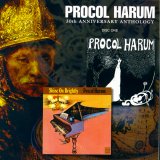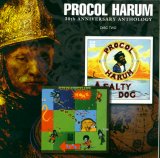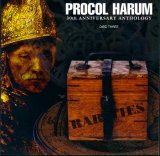30th Anniversary
Anthology
3-CD Boxed Set from
Westside
Jens Anders Ravnaas
 As a long-term Procol Harum fan, I always skim the music
stores for new CDs from Procol Harum. I search the Internet
online stores, and read the music magazines as I hope to find
something new and listenable from the band. Last year's re-issues
of some of their last albums was great, as it offered an
opportunity to get them on the more user-friendly CD format. Then
came The Long Goodbye – The Symphonic Music of Procol
Harum and Within our House, the live recording from
Gary Brooker's church concert. 1996 was a promising year for us
all.
As a long-term Procol Harum fan, I always skim the music
stores for new CDs from Procol Harum. I search the Internet
online stores, and read the music magazines as I hope to find
something new and listenable from the band. Last year's re-issues
of some of their last albums was great, as it offered an
opportunity to get them on the more user-friendly CD format. Then
came The Long Goodbye – The Symphonic Music of Procol
Harum and Within our House, the live recording from
Gary Brooker's church concert. 1996 was a promising year for us
all.
On the Internet the Procol Harum community began to ask for a
Procol Harum boxed set, and the thirty-year anniversary of A
Whiter Shade of Pale and of Procol Harum's formation seemed
to be a suitable time.
And then, as the big anniversary celebration at Redhill was
getting closer, the music magazines started to write about
forthcoming re-issues. The German label, Repertoire, was said to
be in the process of releasing Procol Harum's first four albums,
digitally remastered and with bonus tracks. And the moment we
arrived at Redhill, the great news from Mojo Magazine was
about a forthcoming 3-CD box set with the four first albums and
bonus tracks: a stereo version of A Whiter Shade of Pale was
to be the major treat. The nightly conversation in the pub at
Lakers Toby Hotel in Redhill those July days raised these
fundamental questions several times: what would the bonus tracks
be, on the re-issues soon to come? And which of them should you
buy? (I guess most of us gathered there would opt for them all,
without hesitation). Now we know the answer.
The Repertoire CDs were released first, and, as expected,
delivered better sound than on earlier CD releases. The bonus
tracks brought little new, except that some of them had not been
available on CD before. The stereo version of Homburg is
probably the most interesting on the set, while Il Tuo
Diamante is also a rarity (both are bonus tracks on the Shine
on Brightly CD).
I had great expectations when Westside’s boxed set
arrived in the mail. The last years have seen several great boxed
sets: The Beach Boys' 30 Years of Good Vibrations and the
huge The Beatles Anthology are two well-received examples.
The Procol Harum boxed set has a more modest approach: three
CDs in a cardboard box and a 12-page booklet in the first CD. The
covers are nice, showing a painting of the Spanish Conquistador
and the cover artwork from the original albums. And Henry Scott-Irvine’s
liner notes really say what needs to be said. But one can’t
help but regret that Westside neglected the possibility of
publishing Keith Reid’s wonderful lyrics to these songs, one
feature these albums never had. And one can’t expect every
Procol Harum fan to have access to the Internet and to this
website. I haven’t asked Westside, but maybe copyright
problems lie behind this omission.
The first two CDs are occupied with Procol Harum’s first
four albums, and the third CD is the promising Rarities CD.
I guess most of you will, like me, put this CD in the player
first, eager to hear the stereo version of A Whiter Shade of
Pale. But let me first dwell for a moment on the other two
CDs.
CD One holds Procol Harum's first two albums, Procol
Harum and Shine On Brightly. The contents should be
well known to visitors of this website. I’ll just say that
the track list is the original, without the single A Whiter
Shade of Pale. And the artwork shows the original English
cover of Shine on Brightly. No surprise here: what really
surprised me was the sound-quality. Remastering has been done
before, but Tom Moulton and Greg Vaughn at Frankford/Wayne
Mastering Labs have done a better job than most. Even the badly-produced
Procol Harum album sounds great. Containing maybe Procol
Harum's best material, this CD does more justice to the music
than has ever been done before. Many have asked for a separate
issue of the Rarities CD, without the first four albums. I
tell you: you don’t want that. Even if you have bought the
first albums before, both on vinyl and CD, you will want this
issue. The sound-quality justifies the money spent.
 CD Two holds A Salty Dog and Home,
without A Salty Dog's title track, which has been moved to
CD Three. And this is my only criticism of these two CDs: A
Salty Dog should have been in its proper place. But the song
was apparently moved because of time restrictions: an unavoidable
action. Again I was impressed by the sound quality, and the new
details that suddenly were present in the music.
CD Two holds A Salty Dog and Home,
without A Salty Dog's title track, which has been moved to
CD Three. And this is my only criticism of these two CDs: A
Salty Dog should have been in its proper place. But the song
was apparently moved because of time restrictions: an unavoidable
action. Again I was impressed by the sound quality, and the new
details that suddenly were present in the music.
CD Three is obviously the most exciting. It starts out
with the singles from that period, A-sides and B-sides from A
Whiter Shade of Pale to Long Gone Geek. A Salty Dog
is included here in its right context, as it was a single A-side
in May ’69. Quite Rightly So (from the Shine On
Brightly album) is repeated here, this time in the slightly-different
single version.
And then come the rarities: Monsieur Armand and Seem
To Have The Blues (Most All The Time)’ are outtakes from
Shine on Brightly, recorded in October ’67.
They have both been heard before on the Rock Roots compilation
and are also included on the recent Repertoire issue of Procol
Harum.
A Whiter Shade of Pale – stereo version – is
next. This is a different recording from the released version. It
is apparently recorded before the better-known version, and
original drummer Bobby Harrison is in the line-up. The originally-
released version had session musician Bill Eyden on the drums:
the two men's drumming is quite different. This stereo version
has been mixed from a four-track master by Tom Moulton. Listening
to it, it becomes apparent how far producing techniques have come
since ’67. The sound quality is far superior to the original
version. Tom Moulton has also mixed the instruments differently:
the drums are more crisp, and, most important, Gary Brooker’s
piano is audible through Matthew Fisher’s Hammond. This take
of AWSoP is played more slowly and laid-back, and Matthew’s
Hammond sounds different. I still prefer the original released
version of AWSoP, but this stereo version sounds good, and
brings new details to the million-seller. This version also has a
different ending: there is no fadeout, but the song is terminated
with the ending usually played in concerts
And now is time for Karaoke. A previously-unreleased backing
track for A Whiter Shade of Pale is next, this time with
Bill Eyden on the drums; it must have been recorded on the same
day as the released single. It has a different ending, and you
can clearly hear Gary’s piano 'honking away' towards the end:
obviously not a take intended for release. Although suitable for
a singalong, this instrumental track has more to offer: it
amplifies the instrumental variations in the song, and it also
shows clearly that the song needs Gary’s singing as well as
it needs Matthew’s Hammond.
Homburg is on track 3 of this CD, as the A-side of
Procol Harum's second single. And here on track 13 is the now not-so-unknown
stereo version of Homburg. If you have never listened to
it: enjoy. It will give you a better perspective on this top ten
single. If you have heard it, you know what I mean.
Track 14 is an earlier take of Homburg and, like the
stereo AWSoP, it has been mixed from a four-track tape by
Tom Moulton. If you listen carefully during the fadeout on the
single version of Homburg you hear Matthew Fisher’s
Hammond playing some wonderful chorale like tunes. I always
regretted the fadeout, because I wished I could hear more. Now I
can! This alternative take has several verses with Matthew
playing his wonderful stuff. If Tom Moulton’s mixing of AWSoP
gave Gary Brooker's piano more attention, this version of Homburg
helps the Hammond to shine.
 Alternative takes of Conquistador and She Wandered
Through The Garden Fence are next, this time in stereo. It
makes you wonder whether a stereo version of Procol Harum's first
album could be reconstructed with these alternative takes?
Alternative takes of Conquistador and She Wandered
Through The Garden Fence are next, this time in stereo. It
makes you wonder whether a stereo version of Procol Harum's first
album could be reconstructed with these alternative takes?
The box set concludes with a 1967 version of Magdalene (My
Regal Zonophone), the only track that disappoints me with its
sound quality. But the liner notes say it has been taken from an
acetate, which accounts for the sound [2007:
vastly-better sounding version now available from Salvo Records]. And the Beatles Anthology
had this acetate quality on most CDs, and still sold millions
... .
Which one should I buy? The Repertoire CD or Westside's
Anniversary box set? I would say both. But if you are not a
completist like myself, you should settle for the Westside box.
The sound-quality is far superior, and the bonus tracks are more
exciting. The Online Music store 'CD-Now' lists each of the four
Repertoire CDs at $19.99 each, while the Westside box is $40.99.
So even from the economical point of view, you should send your
money to Westside.
Has Westside more up in its sleeve? I don’t know, but I
can always make a wish: give us three more boxed sets, one with
Procol Harum’s four next albums and one with the final three
CDs. The same recipe should be used: add an extra CD with
interesting bonus tracks.
From this website and others, I know that live recordings are
on top of our wish list. Lots of bootlegs are available, but they
usually are harder to get and less nice looking. It was a
disappointment for many that this boxed set didn’t include
some live recordings. But maybe a fourth CD for each boxed set
should be made available to hold various live recordings from
that time period. Readers of this website might have seen the
wish lists for such a CD.
Conclusion: Buy this boxed set: it helps Procol Harum
really Shine on Brightly in your stereo.
Track Listing
Buy
the 30th Anniversary Anthology from Amazon USA
Buy
the 30th Anniversary Anthology from Amazon UK
 As a long-term Procol Harum fan, I always skim the music
stores for new CDs from Procol Harum. I search the Internet
online stores, and read the music magazines as I hope to find
something new and listenable from the band. Last year's re-issues
of some of their last albums was great, as it offered an
opportunity to get them on the more user-friendly CD format. Then
came The Long Goodbye – The Symphonic Music of Procol
Harum and Within our House, the live recording from
Gary Brooker's church concert. 1996 was a promising year for us
all.
As a long-term Procol Harum fan, I always skim the music
stores for new CDs from Procol Harum. I search the Internet
online stores, and read the music magazines as I hope to find
something new and listenable from the band. Last year's re-issues
of some of their last albums was great, as it offered an
opportunity to get them on the more user-friendly CD format. Then
came The Long Goodbye – The Symphonic Music of Procol
Harum and Within our House, the live recording from
Gary Brooker's church concert. 1996 was a promising year for us
all. 
 CD Two holds A Salty Dog and Home,
without A Salty Dog's title track, which has been moved to
CD Three. And this is my only criticism of these two CDs: A
Salty Dog should have been in its proper place. But the song
was apparently moved because of time restrictions: an unavoidable
action. Again I was impressed by the sound quality, and the new
details that suddenly were present in the music.
CD Two holds A Salty Dog and Home,
without A Salty Dog's title track, which has been moved to
CD Three. And this is my only criticism of these two CDs: A
Salty Dog should have been in its proper place. But the song
was apparently moved because of time restrictions: an unavoidable
action. Again I was impressed by the sound quality, and the new
details that suddenly were present in the music.
 Alternative takes of Conquistador and She Wandered
Through The Garden Fence are next, this time in stereo. It
makes you wonder whether a stereo version of Procol Harum's first
album could be reconstructed with these alternative takes?
Alternative takes of Conquistador and She Wandered
Through The Garden Fence are next, this time in stereo. It
makes you wonder whether a stereo version of Procol Harum's first
album could be reconstructed with these alternative takes?